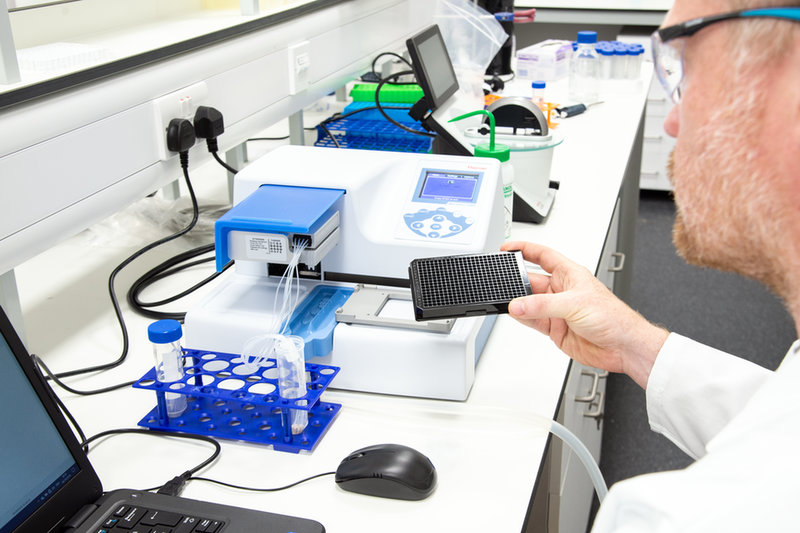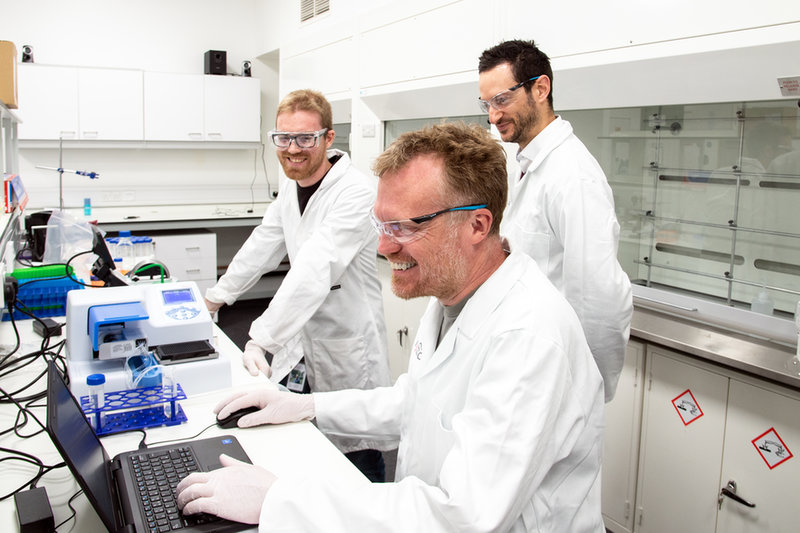Diagnostics
A nose for trouble:
the bio-sensor aiming to sniff out disease
A University of Bristol spinout is developing a new biosensor array inspired by the mammalian olfactory system to improve diagnostics and chemical analysis. How could this biologically-inspired approach improve the analysis of pharma compounds and the diagnosis of disease? Chris Lo finds out.
A
s the medical industry continues its quest for accurate and reliable diagnostic tools, more is becoming understood about the science of the sniff. The olfactory system of mammals is a powerful bio-sensor, its complex network of receptors capable of receiving and distinguishing between a near-unlimited number of odours and other chemical compounds.
There is perhaps no better demonstrator of the power of mammalian olfaction than man’s best friend. Dogs have around double the number of olfactory biosensors when compared to humans, providing a much greater specificity of detection. Past and ongoing studies have been delving into the clinical potential of this canine super-sense, trialling the ability of trained dogs to match or even outperform modern diagnostic technologies when sniffing out the chemical signatures of diseases ranging from cancer and diabetes to malaria and Parkinson’s disease.
In April 2019, cancer screening firm BioScentDX presented a study that found that four trained beagles were able to correctly identify lung cancer samples with 96.7% accuracy, offering the prospect of a non-invasive test and more frequent screening, which is usually limited by the radiation exposure involved.
Inspired by mammals:
building an organic chemical sensor
Rather than using dogs directly, a University of Bristol spinout company called Rosa Biotech is taking a different approach. The company was incorporated in January 2019 to develop and commercialise products based on the academic work of Professor Dek Woolfson at the Bristol BioDesign Institute. Woolfson and his team built a series of barrel-shaped proteins that mimic the mammalian olfactory system, but with a simpler structure that makes them easier to produce and handle.
“It is these barrels that provide the basis for Rosa’s technology,” Woolfson said earlier in 2019. “We make arrays of different barrels, load each barrel with a dye, and then expose the array to something that we want to analyse, for instance a bodily fluid that may show signs of disease. Molecules in the sample dislodge the dyes to different extents across the array. This gives coloured patterns that are analysed using machine learning. By recording patterns for healthy and diseased samples, we hope to build sensors for early-stage diagnosis of disease.”
These manufactured protein barrels underpin every application being pursued by the company, which include both clinical uses and conversations with other industries, including the food and drinks sector.
“We use exactly the same sensor for all of those different applications as we’re developing for diagnostics,” says Rosa Biotech CEO Dr Andy Boyce. “So actually the only thing that’s different is the way in which we analyse that data or perhaps pre-treat some of the samples, but at the point they go on to the sensor, it’s exactly the same sensor each time.”
“We hope to build sensors for early-stage diagnosis of disease.”
Ultimately the company’s platform has the potential to achieve a breakthrough in so-called array-based differential sensing; in other words, the ability to run a sample through a sensor array to look for subtle changes in the reaction without knowing exactly what you’re looking for. Work has been done in the past to develop non-organic differential sensor arrays (or ‘electronic noses’) such as metal oxide sensors, but Boyce notes that these have fallen by the wayside due to the instruments’ lack of sensitivity. A biologic array like Rosa’s could make differential sensing work, tackling many of the disadvantages of developing molecule-specific tests.
“The more we come to understand the biology of diseases, the more we realise how little we know about how much variability there is with diseases, especially in chronic diseases, from individual to individual,” Boyce says. “You might develop a test that detects a single molecule or a single protein in a patient, and that might be very indicative but only in a very small number of people – in which case you’re missing the opportunity to make an early diagnosis in a much larger percentage of people.”

Pharma chemical analysis emerges as early application
While the protein barrels are the common feature, finding diagnostic applications is more of a long-term goal of the company, partly because the best disease candidates for disruption need to be identified, and partly because the machine learning algorithms that will analyse the sample results will need extensive training to keep up with the demands of differential sensing.
“There’s a need to do an awful lot of training on our side,” Boyce notes. “If and when we get to the level of releasing a diagnostic test, that will have to be backed up by some very large cohorts and sample data, so we can be totally confident that the results we give are robust and accurate. That will be underpinned by machine learning, but also all of the stats and databasing and other activities that sit behind that.”
While that work is ongoing, the company has been in conversations with large pharma organisations about a different use in the production of biologics. These high-value drug APIs are typically cultured in massive 10,000-litre vats that contain a complex biologics soup of ingredients designed to support the growth of cells – usually Chinese hamster ovary (CHO) cells – that have been genetically modified to produce a given biologic.
“In one single batch you might make $25m worth of final product, so there’s a huge impetus to increase yield.”
The problem for many manufacturers is that biologic yield of a single vat can swing up to 20% in either direction, making it very hard to predict output. Rosa’s bio-sensing barrels could help, and the company is already working with pharma clients on this application, having run a successful pilot project earlier in 2019.
“We did a pilot study with one of the big UK pharmaceutical companies to look at whether our system was better than some of the existing analytical chemistry techniques,” says Boyce. “We showed that we could effectively predict final yield based on some of the starting materials, and that we were equivalent or better than existing techniques and that we were a lot cheaper and faster. Within biologics, in one single batch you might make $25m worth of final product, so there’s a huge impetus to increase yield but also get better consistency of yield. The pharma companies are very worried about security of supply. If they have active treatment programmes, they can’t just run out of these medicines.”

Smell of success: diagnostic benefits
As for Rosa’s diagnostic ambitions, Boyce says the company is working with clinicians to highlight diseases where there is an unmet need in terms of testing, and for which earlier diagnosis would have the largest impact on clinical outcomes.
“We’re also leveraging some of the resources within the university and other places,” he continues. “We’re getting access to samples from large biobanks, so again we’ll need to train our platform and our machine learning algorithm with some large sample sets.”
Any test based on Rosa’s platform will likely analyse liquid samples; although Boyce says the arrays could analyse volatile organic compounds taken from breath samples, other companies such as Owlstone Medical “have that really well nailed down”.
“We can go back and examine the impact of each of the barrels on the final signal.”
Rosa plans to continue to expand the range of barrels it can create and work out which configurations may be best-suited to certain diagnostic uses, as well as experimenting with new dyes and basic chemistry to enhance the specificity of results. One advantage of leaning on machine learning and building up large data-sets is the ability to quickly fine-tune the company’s core technology.
“We can go back and examine the impact of each of the barrels on the final signal,” says Boyce. “We can go back and say, ‘For this particular application, barrel X isn’t having a big impact or the signal we get is the same as one of our other barrels so it’s redundant.’ We can use that information to switch that one out. Equally, if we find that there are barrels that are making a really big impact to the signal, we can iterate and make lots of different variants around those, and then use that to get some more fine-grain information about what’s going on in the sample.”
Bristol: a flourishing hub for biotech spinouts
Rosa Biotech is one of the UK’s start-up success stories, recently raising £750,000 in angel investment and in October jointly winning the Royal Society of Chemistry’s Emerging Technologies 2019 award. All this within a year of incorporating as a company, and just a few months after the company “really got going” in July at the new Unit DX biosciences hub in Bristol, according to Boyce.
“A lot of that comes from the quality of research at the University of Bristol,” he says. “Bristol has not traditionally been a hotbed of spinouts in the life sciences area; up until a few years ago it was probably only doing one or two spinouts a year. Now it’s doing 10-12 spinouts a year.”
The turn towards entrepreneurialism is a process Boyce is seeing across the UK, driven from virtually all sides.
“There’s a general trend towards start-ups becoming a key part of the innovation eco-system.”
“There are incentives from all quarters to do more of this,” he says. “There’s a huge drive from government to demonstrate impact from research funding. I think more generally, universities are looking to diversify how they’re generating income, but also it’s being driven by the fact that students themselves are much more interested in entrepreneurship.
"Plus, if you look at big pharma, they’re doing less and less of the basic science and looking more and more to outsource that to early-stage companies so they can outsource the risk. There’s a general trend towards start-ups becoming a key part of the innovation eco-system.”
As for Rosa’s future, the spinout is already spending its recently-raised funds on new staff and equipment, and will focus on generating solid proof-of-concept data to get the conversation started on diagnostics.
“We’ve got some early proof-of-concept data, but we need to get something that is convincing to clinicians and to potential diagnostic technology partners,” Boyce says. “It depends exactly what our business model is, but we may choose to partner with one of the big diagnostic technology developers like Abbott or Roche rather than taking it all the way through the clinic ourselves.”